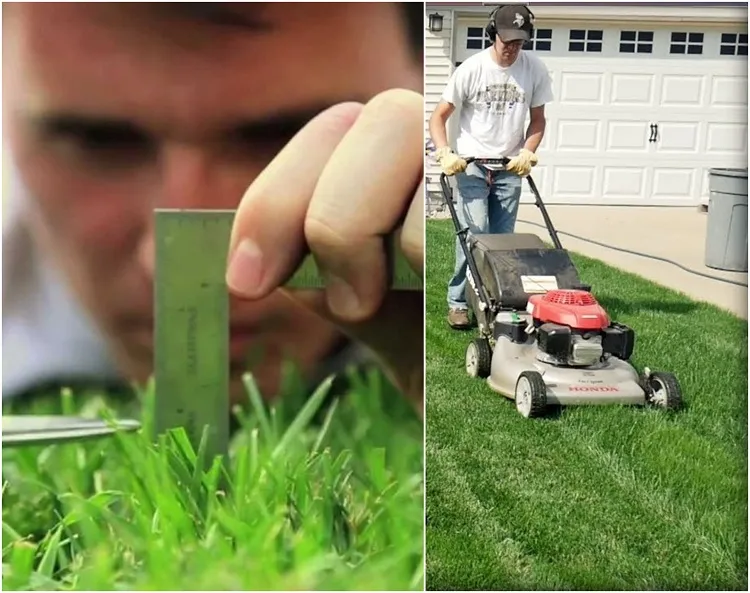A well-maintained lawn is a beautifully green and valuable possession to any property. But to keep this emerald green and cheerful look, you should renew it with new grass seeds several times throughout the year. This is known as overseeding, which is a popular technique for rejuvenating and enhancing the appearance of your lawn. It’s performed by spreading grass seeds over the existing green coverage to fill in thin areas, improve density, and introduce new plant varieties. Overseeding is an effective way to have a lush lawn, though some additional care is needed in maintaining your grass for achieving best results. One of the most important things to know is how to choose the exact time you should cut the growing green coverage. We are going to guide you today when to mow the new grass after overseeding, and answer some other important questions, in connection with cutting your lawn.
How Long to Wait to Cut Lawn After Overseeding?
One of the main considerations you should think about for maintaining the green coverage is when to mow new grass after overseeding. It is essential to give the new grasses enough time to establish themselves before cutting them. The waiting period typically ranges from two to four weeks, depending on various factors such as the variety of the grass, weather conditions, and the growth rate of the seedlings. During this time, the newly seeded plants will undergo germination and develop delicate roots, with which to anchor themselves into the soil. So, when you wait for a few weeks, you give the new seedlings a chance to form and grow to a height of around 3 to 4 in (7.5-10 cm). At this stage, the young plants will have developed a strong root system, making them more resilient to mowing. Cutting the lawn too early can damage the fragile seedlings and hamper their growth, impairing the purpose of overseeding.
Important Things to Know for Cutting the Overseeded Grass
Now, that you know exactly when to mow new grass after overseeding, it’s time to learn some other good practices, in connection with the cutting. Firstly, adjust your lawnmower to a higher cutting height than usual. Set it at around three inches (7.6 cm) or more to ensure that you don’t remove too much of the newly established grass, and exclude any risk of stressing or damaging it. You should also keep your lawnmower blades enough sharp, because dull ones can tear the plants rather than making clean cuts, leaving them susceptible to disease and stress. Sharp blades will promote healthy growth and reduce the risk of damage.
What is the Best Temperature to Reseed Grass?
Knowing when to mow new grass after overseeding and having made your cutting, you should be ready shortly after to reseed your lawn. There are a few key considerations to keep in mind. Firstly, the success of this action is in strong connection with the prevailing weather conditions. The ideal temperature for reseeding grass is during the cooler months of spring or fall, when the soil temperature is between 50-65 °F (10-18 °C). As these are optimal conditions for seed germination and grass establishment. Refrain from overseeding during the hot summer months, when high temperatures and dry conditions can impede plants germination and increase the risk of seedling mortality. It’s evident that this action is not possible in the winter, when the ground is frozen or at least temperatures are consistently below freezing.
What Time of Day Should You Reseed Your Grass?
The timing of when you reseed your grass is significant for the success of this process. The best day hours for doing this is in the morning or in late afternoon. During these times, temperatures are lower, and the sunlight is less intense, which is an ideal environment for seed germination. Avoid reseeding in the hottest part of the day, because the excessive heat and direct light can dry out the soil and hinder the germination of grass. It’s also good to take in mind that choosing a calm day without strong winds will help the even distribution of seeds. This will ensure that they’ll be not blown away before having a chance to establish.
How Deep Should You Aerate Your Lawn?
When it comes to aerating your lawn, the depth on which you’re making this is of vital importance for your grass. For most lawns, a depth of 2 to 3 in (5 to 7.6 cm) is recommended, as it allows for effective penetration of water and nutrients into the soil without causing excessive disruption.
However, in compacted lawn areas, especially in high-traffic zones, there is a need for slightly deeper aeration to break up the hard soil layer. It’s important to strike a balance and avoid doing this too deeply, as it can damage the grassroots and interfere to the grass feeding.







